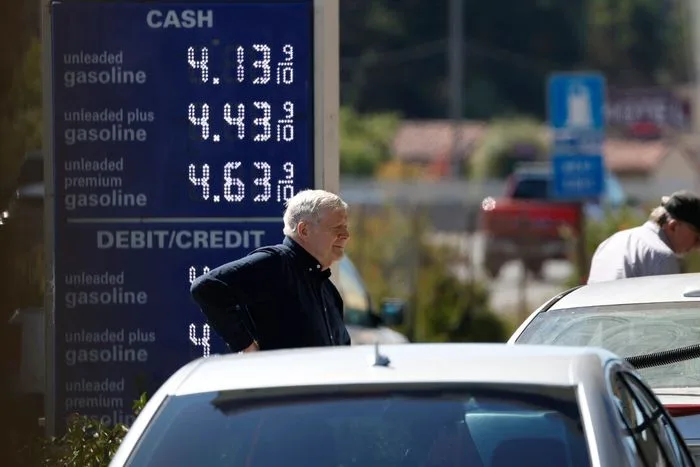By John Haughey
Falling oil prices will spur a decline of about 20 cents per gallon of gasoline on average across the United States by the end of 2025, the U.S. Energy Information Administration is projecting in its Sept. 9 short-term energy outlook.
“We expect the U.S. average retail price for regular-grade gasoline will average about $3.10 per gallon this year, down 20 cents per gallon from last year,” the administration said in its monthly analysis, forecasting that retail gasoline prices will fall to an average of $2.90 per gallon in early 2026 across the nation.
However, there remained an exception: the West Coast, the report said, citing the loss of nearly 20 percent of the region’s gasoline refining capacity after Phillips 66’s October 2024 decision to close its Wilmington refinery and Valero’s April announcement it was shuttering its Benicia refinery.
Otherwise, the administration notes, “U.S. drivers’ gasoline expenditures as a share of disposable personal income are likely to be the lowest since at least 2005”—excluding pandemic-skewered 2020—by nearly a half-percent to “average less than 2 percent of disposable income.”
Previous short-term outlooks projected declining domestic gasoline consumption in 2026 but, “We now forecast a slight increase in U.S. gasoline consumption next year,” it said.
The cost of gasoline is projected to decline in the United States in tandem with falling global crude oil prices, which the administration projects “will decline significantly” through 2025 by nearly $10 a barrel from August and continue to dip in early 2026.
The average price per barrel of the benchmark Brent Crude was $68 in August and $66.39 per barrel on Sept. 9.
The administration forecasts the price per barrel will average about $59 for October through December, then fall to around $50 early next year.
“The price forecast is driven by large oil inventory-builds as OPEC+ members increase production,” it said, referring to the August announcement by eight of the 22-nation cartel’s members to make “voluntary adjustments” in their 2022 production plans to boost output.
That increase in crude production by Saudi Arabia, Russia, Iraq, UAE, Kuwait, Kazakhstan, Algeria, and Oman will tally “inventory-builds [that] will average more than 2 million barrels per day between October 2025 and March 2026,” the administration projects.
“We expect low oil prices in early 2026 will lead to a reduction in supply by both OPEC+ and some non-OPEC producers, moderating inventory-builds later in 2026,” the report states, meaning prices could begin to increase by spring 2026.
S&P Global projects the average price of Brent crude could dip even further, to as low as $55 a barrel by December 2025 and below $50 in early 2026.
“If there’s a massive surplus, if Russian oil continues to flow into the market, if stock-building stops and some of this stuff goes into commercial inventory … we can see a lower price than that,” S&P Global Commodity Insights Co-President Dave Ernsberger said Sept. 9 at the Asia Pacific Petroleum Conference in Singapore.
China and India are the primary destinations for Russian crude. Their imports have increased since the European Union in December 2022 imposed an embargo on seaborne oil imports from Russia in response to the Kremlin’s February 2022 invasion of Ukraine.
But European nations—primarily landlocked Hungary, Slovakia, Czech Republic—still import up to 600,000 barrels a day via the Druzhba pipeline.
President Donald Trump in August increased tariffs on India for its buying oil from Russia, bringing the total levy to 50 percent and, on Sept. 4, pressed European leaders to halt purchases of Russian oil and urged them to pressure Beijing for supporting the Kremlin’s war effort.
During a virtual summit with Ukraine’s allies, Trump said Russia earned $1.2 billion from fuel sales to EU nations in the last year.
Trump announced Sept. 7 that he’ll meet with European leaders in Washington this week to discuss “the second phase of sanctions” in pressuring Russia to end the war. The boost in OPEC+ production—the Energy Information Administration forecast does not include the cartel’s Sept. 7 announcement of an additional 137,000 barrels per day output in October—has lowered global crude prices by 12 percent in 2025.
It’s been good for consumers but not good for the United States’ oil industry.
ConocoPhillips, the nation’s third-largest oil producer, announced in early September it was trimming its workforce by 25 percent. Chevron, the second-largest U.S. oil company, began layoffs last spring that will trim 20 percent—8,000 workers—from its workforce.
As a result of falling crude oil prices, “we expect drilling activity in the United States to be more centered in natural gas-intensive producing regions in 2026,” the administration said in its short-term outlook, especially with demand for liquified natural gas (LNG) exports at record highs, which is expected to continue increasing.
United States’ producers exported an all-time record high of 9.33 million metric tons of LNG in August with two-thirds—6.16 million tons—shipped to Europe, Reuters reported on Sept. 2, citing preliminary ship-tracking data compiled by London-based LSEG.
With a July 27 trade deal between European Union Commission President Ursula von der Leyen and President Donald Trump for European nations to purchase $750 billion in U.S. energy commodities over the next three years, LNG exports to the continent and elsewhere are forecast to significantly increase.
That, too, comes with a good news-bad news qualifier.
As LNG export demand increases, without additional pipeline capacity to move natural gas from “hole-to-hearth,” prices are projected to increase by more than $1.40 per million British thermal unit (MMBtu) between late 2025 and 2026, from $2.91 MMBtu to $4.30 MMBtu, the report forecasts.
“Rising natural gas prices reflect relatively flat natural gas production amid an increase in U.S. liquefied natural gas exports,” the administration states.
This increase in natural gas costs—which the administration said generated 42 percent of the nation’s electricity in 2024—comes as power demand is, as projected, ramping up.
“We expect total U.S. generation by the electric power sector will grow by 2.3 percent in 2025 and a further 3 percent next year,” the short-term outlook projects. “We expect solar power will supply the largest share of the increase in both years.”






